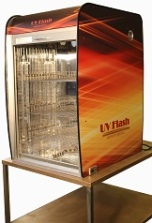
Interior of a Yankauer suction tip cut open length-wise demonstrating evidence of the cleaning challenge presented.
Many don’t realize just how big of a problem dirty surgical instruments can be. When organic debris remains in or on a surgical device, it can be a huge threat to patient safety. The industry holds established standards for reprocessing a wide variety of surgical instruments, requiring rinsing, soaking in enzymatic solution, hand brushing and washing in an automated reprocessor. However results can vary due to the variety of devices involved, variations in shape, size and composition, and types of contaminants the devices are exposed to.
AORN published a study last year called Uphill Grime, written by Jahan Azizi who worked with Midbrook through this study. In the study, Azizi tested reprocessing methods of suction tips; available in a wide variety of shapes, angles, and sizes, and are exposed to all types of fluids, tissues, pathogens, and other contaminants. In the initial investigation, they followed the manufacturers’ instructions for use which included manual rinsing and brushing, soaking visibly soiled devices in enzymatic solution for 30 minutes. Then suction tips were placed in an automatic reprocessor and performed quality checks according to the IFU. A fiber-optic camera determined many suction tips still contained debris even after the IFU was completed. The insight found from the testing showed:
– Brushes used for cleaning must be available in a variety of sizes to fit the various sizes and shapes of the suction tips
– Many brushes were too soft to tackle the debris
– After suction tips were cleaned a few times, the debris became packed into the insides of the tips making it more difficult to scrub
– After each soaking and ultrasonic process, an unwanted brownish fluid was coming from the ends of the suction tips
– Suction tips should be process separately from other items due to more time required for cleaning
The results of the study indicated that the increasing sophistication of medical instruments has resulted in instruments that may be impossible to clean with current technology. A more fully automated method would ensure consistent and repeatable results.
By using the Midbrook Tempest, the process brings high-powered, industrial-grade cleaning with repeatable results to your Central Processing Department. Lumened instruments are flushed with enzymatic cleaner 3 times during the wash cycle to achieve optimal cleaning results that cannot be achieved by manual cleaning. The Tempest can clean up to 48 lumened instruments in 30 minutes which is much less time-consuming than manual washing.





 In Meadowbrook, PA., at Holy Redeemer Hospital, they are trying something new. An innovative idea aimed to cut down on infection rates that also fits beautifuly into their budget. It all came about when they started to see a spike in hospital infection rates. They attempted to battle the bug with the usual approaches like patient isolation and increasing their use of bleach, but to no avail. That’s when they started taking a few notes from Jamie Lee Curtis. Remember those
In Meadowbrook, PA., at Holy Redeemer Hospital, they are trying something new. An innovative idea aimed to cut down on infection rates that also fits beautifuly into their budget. It all came about when they started to see a spike in hospital infection rates. They attempted to battle the bug with the usual approaches like patient isolation and increasing their use of bleach, but to no avail. That’s when they started taking a few notes from Jamie Lee Curtis. Remember those 